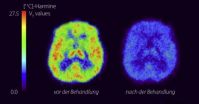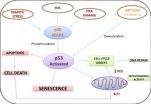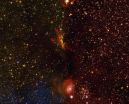(Press-News.org) This news release is available in German.
Many women suffer from baby blues after giving birth. Some even develop full-blown postpartum depression in the weeks that follow. Monoamine oxidase A, an enzyme responsible for the breakdown of neurotransmitters like dopamine and serotonin, plays an important role in this condition. In comparison to healthy women, women who experience postpartum depression present strongly elevated levels of the enzyme in their brains. This was discovered by a Canadian-German research team including Julia Sacher from the Max Planck Institute for Human Cognitive and Brain Sciences in Leipzig. Their findings could help in the prevention of postpartum depression and in the development of new drugs for its treatment.
For most women, the birth of their baby is one of the most strenuous but also happiest days in their lives. However, joy and happiness are often followed by fatigue and exhaustion. The vast majority of women experience a temporary drop in mood for a few days after birth. These symptoms of "baby blues" are not an illness; however, in some cases they can represent early signs of an imminent episode of depression: in 13 percent of mothers, the emotional turmoil experienced after childbirth leads to the development of a full-blown postpartum depression. Postpartum depression is harmful not only to the mother, but also to the baby. It is difficult to treat this condition effectively, as its precise neurobiological causes have remained unidentified to date.
The new study shows that postpartum depression is accompanied by strongly elevated monoamine oxidase A in the brain, particularly in the prefrontal cortex and in the anterior cingulate cortex. In women with postpartum depression, the values recorded were 21 percent higher than those of women who were not plagued by negative feelings after giving birth. Women who did not develop full-blown depression but found themselves crying more often than usual due to depressed mood, also presented moderately elevated values.
"Therefore, we should promote strategies that help to reduce monoamine oxidase A levels in the brain, and avoid everything that makes these values rise," explains Sacher. Such factors include heavy smoking, alcohol consumption and chronic stress, for example when the mother feels neglected and abandoned by her partner and family. "My ultimate goal is to provide women and their families with very concrete lifestyle recommendations that will enable them to prevent postpartum depression," explains the psychiatrist.
A new generation of long-established drugs could also play an important role in the treatment of postpartum depression in future. Up to now, depressed mothers are mainly given drugs that increase the concentration of serotonin in the brain. However, because monoamine oxidase A breaks down not only serotonin but also other monoamines like dopamine and noradrenaline, a treatment that directly targets monoamine oxidase A could have a higher success rate, particularly in very serious cases: this alternative is provided by selective and reversible monoamine-oxidase- A inhibitors. "The first monoamine oxidase inhibitors often had severe side effects, for example hypertensive crises, which necessitated adherence to a strict diet," explains Sacher. "However, the new selective and reversible drugs are better tolerated," she adds. In the next stage of this research involving clinical trials, the scientists intend to test the effectiveness of these reversible monoamine oxidase A inhibitors in the treatment of postpartum depression.
Because the measurement of this enzyme in the brain requires complex technology, it is not suitable for routine testing. Thus, the researchers are also looking for a peripheral marker of this enzyme that can be detected in saliva or blood.
Four years ago, Julia Sacher and her colleagues at the Centre for Addiction and Mental Health CAMH in Toronto already succeeded in showing that, in the first week postpartum, the concentration of the enzyme monoamine oxidase A in the brain is on average 40 percent higher than in women who had not recently given birth. "The monoamine oxidase A values behave in the opposite way to oestrogen levels. When oestrogen levels drop acutely after childbirth, the concentration of monoamine oxidase A rises. This drastic change also influences serotonin levels, known as the happiness hormone," explains Dr. Sacher. In most women, the values quickly return to normal. In others, they remain raised – and thereby promote the development of depression.
INFORMATION:
Original publication:
Julia Sacher, P. Vivien Rekkas, Alan A. Wilson, Sylvain Houle, Leslie Romano, Jinous Hamidi, Pablo Rusjan, Ian Fan, Donna E. Stewart, Jeffrey H. Meyer
Relationship of Monoamine Oxidase A Distribution Volume to Postpartum Depression and Postpartum Crying
Neuropsychopharmacology, 30 July 2014 (doi: 10.1038/npp.2014.190)
Monoamine oxidase A: Biomarker for postpartum depression
Postpartum mood swings correlated with high monoamine oxidase A binding
2014-07-31
ELSE PRESS RELEASES FROM THIS DATE:
Research reveals pervasive implicit hierarchies for race, religion, and age
2014-07-31
As much as social equality is advocated in the United States, a new study suggests that besides evaluating their own race and religion most favorably, people share implicit hierarchies for racial, religious, and age groups that may be different from their conscious, explicit attitudes and values.
The study findings appear in Psychological Science, a journal of the Association for Psychological Science.
"People from relatively low-status groups can readily report that their group does not have the most power. At the same time, most groups, even if they have less social ...
Key to aging immune system is discovered
2014-07-31
There's a good reason people over 60 are not donor candidates for bone marrow transplantation. The immune system ages and weakens with time, making the elderly prone to life-threatening infection and other maladies, and a UC San Francisco research team now has discovered a reason why.
"We have found the cellular mechanism responsible for the inability of blood-forming cells to maintain blood production over time in an old organism, and have identified molecular defects that could be restored for rejuvenation therapies," said Emmanuelle Passegué, PhD, a professor of medicine ...
Researchers at SGH and Duke-NUS a step closer to finding treatment for dengue fever
2014-07-31
There have been several news reports that the world's first dengue vaccine will be available next year. However, the latest clinical trials show that the vaccine only provides a protection of around 50 per cent for DENV-2 and DENV-1, which are commonly found in Singapore.
DENV-1 accounts for 90 per cent of infections locally as a large population lacks the immunity against this particular dengue virus serotype. Until a vaccine that can offer higher protection becomes available, it is crucial to find a suitable treatment for dengue fever, as there is presently none available ...
Senescence in adipose-derived stem cells and its implications in nerve regeneration
2014-07-31
Adult mesenchymal stem cells, specifically adipose-derived stem cells have self-renewal and multiple differentiation potentials and have shown to be the ideal candidate for therapeutic applications in regenerative medicine, particularly in peripheral nerve regeneration. Adipose-derived stem cells are easily harvested, although they may show the effects of aging, hence their potential in nerve repair may be limited by cellular senescence or donor age. Cellular senescence is a complex process whereby stem cells grow old as consequence of intrinsic events (e.g., DNA damage) ...
A new way to generate insulin-producing cells in Type 1 diabetes
2014-07-31
VIDEO:
Researchers discover a simple peptide that can induce new beta-cell formation in the pancreas. The findings show promise for a new approach to treating Type 1 diabetes.
Click here for more information.
La Jolla, Calif., July 31, 2014 -- A new study by researchers at Sanford-Burnham Medical Research Institute (Sanford-Burnham) has found that a peptide called caerulein can convert existing cells in the pancreas into those cells destroyed in type 1 diabetes-insulin-producing ...
Researchers uncover cause of gum disease related to type 2 diabetes
2014-07-31
Going to the dentist isn't fun for anyone, but for those with periodontal disease related to type 2 diabetes, a new research discovery may have them smiling. In a report appearing in the August 2014 issue of the Journal of Leukocyte Biology, one of the most important blood cells involved in the human immune response, B cells, are shown to promote inflammation and bone loss in type 2 diabetes-associated periodontal disease. These findings support the idea that treatments that manipulate the responses of B cells may treat or prevent this complication.
"Our study identified ...
Breakthrough in understanding of important blood protein
2014-07-31
The human body contains a unique protein that has the unusual property of destroying itself after a few hours of existence - it must therefore be continually recreated and is no stable protein. The protein, called PAI-1, affects many physiological functions, including the dissolving of coagulated blood. If you get a blood clot, it is due to the fact that the a clot has accumulated in a blood vessel, and therefore PAI-1 is extremely important – for the human body's survival in general and for helping people with a blood clot or other blood diseases in which coagulation plays ...
Common drugs adversely impair older adults' physical as well as cognitive functioning
2014-07-31
INDIANAPOLIS -- A class of medications previously linked to cognitive impairment in older adults also appears to negatively affect their physical functioning according to investigators from the Regenstrief Institute, the Indiana University Center for Aging Research, the University of East Anglia and several other United Kingdom institutions.
In a systemic review of more than a decade of studies on the effects of drugs with anticholinergic properties, they report that these drugs have a significant adverse effect on both cognitive and physical functioning, including the ...
Research finds numerous unknown jets from young stars and planetary nebulae
2014-07-31
For many years astronomers have known that young 'protostars' drive supersonic jets of gas from their north and south poles. However, this is the first time that so many of them have been detected at once.
The results come from a five year survey undertaken with the UK Infra-Red Telescope and are expected to prompt significant changes in the understanding of the planetary nebulae population in the Galaxy, as well as the properties of jets ejected from young forming stars.
By examining images of excited hydrogen molecules at infrared wavelengths, scientists have been ...
The Rim Fire 1 year later: A natural experiment in fire ecology and management
2014-07-31
The enormous conflagration known as the Rim Fire was in full fury, raging swiftly from crown to crown among mature trees, when it entered the backcountry of Yosemite National Park in California's Sierra Nevada in late August 2013. But inside the park, the battle began to turn, enacting a case study in the way management decisions and drought can combine to fuel large, severe fires.
"When the Rim Fire hit the park, it eventually encountered lands where fire had been used as a management tool, rather than immediately suppressed," said Hugh Safford, a regional ecologist ...
LAST 30 PRESS RELEASES:
Heart-brain connection: international study reveals the role of the vagus nerve in keeping the heart young
Researchers identify Rb1 as a predictive biomarker for a new therapeutic strategy in some breast cancers
Survey reveals ethical gaps slowing AI adoption in pediatric surgery
Stimulant ADHD medications work differently than thought
AI overestimates how smart people are, according to HSE economists
HSE researchers create genome-wide map of quadruplexes
Scientists boost cell "powerhouses" to burn more calories
Automatic label checking: The missing step in making reliable medical AI
Low daily alcohol intake linked to 50% heightened mouth cancer risk in India
American Meteorological Society announces Rick Spinrad as 2026 President-Elect
Biomass-based carbon capture spotlighted in newly released global climate webinar recording
Illuminating invisible nano pollutants: advanced bioimaging tracks the full journey of emerging nanoscale contaminants in living systems
How does age affect recovery from spinal cord injury?
Novel AI tool offers prognosis for patients with head and neck cancer
Fathers’ microplastic exposure tied to their children’s metabolic problems
Research validates laboratory model for studying high-grade serous ovarian cancer
SIR 2026 delivers transformative breakthroughs in minimally invasive medicine to improve patient care
Stem Cell Reports most downloaded papers of 2025 highlight the breadth and impact of stem cell research
Oxford-led study estimates NHS spends around 3% of its primary and secondary care budget on the health impacts of heat and cold in England
A researcher’s long quest leads to a smart composite breakthrough
Urban wild bees act as “microbial sensors” of city health.
New study finds where you live affects recovery after a hip fracture
Forecasting the impact of fully automated vehicle adoption on US road traffic injuries
Alcohol-related hospitalizations from 2016 to 2022
Semaglutide and hospitalizations in patients with obesity and established cardiovascular disease
Researchers ‘listen in’ to embryo-mother interactions during implantation using a culture system replicating the womb lining
How changing your diet could help save the world
How to make AI truly scalable and reliable for real-time traffic assignment?
Beyond fragmented markets: A new framework for efficient and stable ride-pooling
Can shape priors make road perception more reliable for autonomous driving?
[Press-News.org] Monoamine oxidase A: Biomarker for postpartum depressionPostpartum mood swings correlated with high monoamine oxidase A binding





